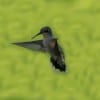 Female hummers lack the colorful gorget you saw on the ruby-throat’s picture and some are quite difficult to tell from other species (such as Black-chinned females). Few birds can hover like hummingbirds and I find it one of the great miracles of Life on Earth that they fly in spring back across the Gulf of Mexico to our shores. In fall, most seem to go around the Gulf as circum-Gulf migrants.
Female hummers lack the colorful gorget you saw on the ruby-throat’s picture and some are quite difficult to tell from other species (such as Black-chinned females). Few birds can hover like hummingbirds and I find it one of the great miracles of Life on Earth that they fly in spring back across the Gulf of Mexico to our shores. In fall, most seem to go around the Gulf as circum-Gulf migrants.
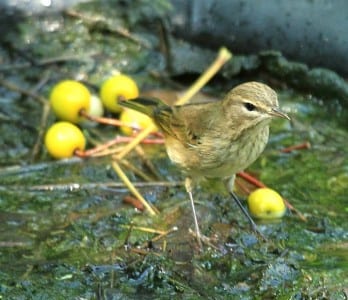
Warblers are the largest family of songbird migrants, although the cryptic sparrows become quite numerous later in the fall as winter residents, and flycatchers have made a strong showing in September. These three families dominate the songbird migrant scene and lead to the amazing diversity which is the spring or fall migration. This is the nondescript Palm Warbler, which is actually a winter resident in various areas of the Upper Texas Coast (and the South). Texas birds are usually the Western Palm, drab and found more in open areas. The Northern Palm Warbler is yellower and found more in pine forests of the coastal plain. These are races of one species, the Palm Warbler, but unlike most avian races, they are quite distinctive and separated ecologically (that means a different habitat).
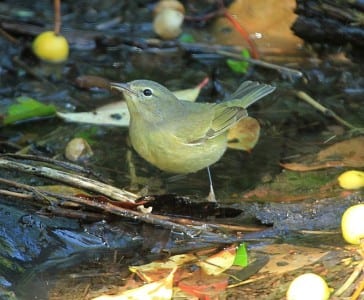
A winter resident species which first arrives at the end of September is the Orange-crowned Warbler. The olive body and gray head helps the ID but the bold eye-ring seals the deal. Orange-crowned has a sharp chip which belies their presence but the equally-sharp bill certainly helps. Also of curious note is the consistent light feather edging on each wing at the bend.
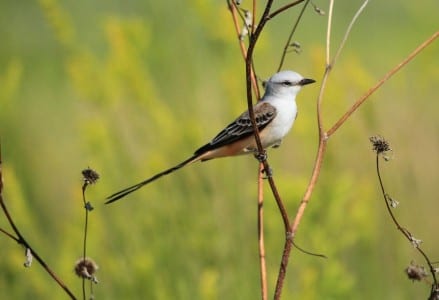
The diverse group of flycatchers is most eloquently represented by the Scissor-tailed, much more common in October than earlier in fall. Aside from the long tail (especially the males), they have salmon flanks and a curious, gray head, neck and chest. These breed in a curiously unique range of North Texas and Oklahoma, plus a few that spill over into places such as the Upper Texas Coast. Flycatchers are a primitive group of songbirds, actually in a separate sub-order, with major structural differences, such as in their syrinx. There are easily-identifiable groups, usually designated by the genus name, such as phoebes, pewees and king birds. But the toughest of all North American birds to identify is the woeful Empidonax flycatchers, around a dozen species, evenly split between our Nation’s East and West. Read on…
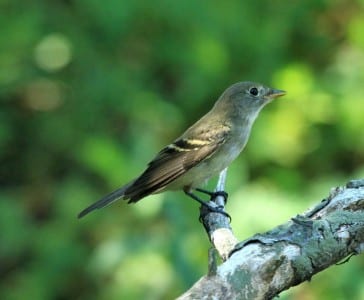
Empidonax flycatchers are small, greenish-gray birds whose differences range from color and pattern to habitat and call notes. In the migration, the latter is most helpful. When I first moved here from Florida, where I (virtually) only saw Acadians, I was lost at the sight of Alders, Willows, Yellow-bellieds and Leasts. However, having many dozens of these little guys in my yard each year, I am only a little lost. 😉 This is the most common of our empids, the Alder Flycatcher. They have a consistent, white eye-ring and a white throat, and the same grayish back color as Willow and Least. They are not as green as Acadian and Yellow-bellied. Those are the five eastern empids but there are another half-dozen out West.
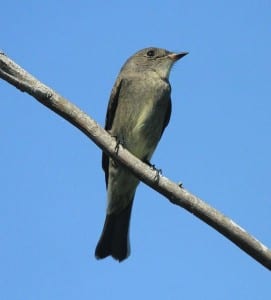
Weather from the West, like we’ve experienced recently, understandably delivers birds from the West. This is the Western Wood-pewee, a slate-colored counterpart to the common Eastern Wood-pewee found all over the East. At the same time we had two Vermilion Flycatchers around, yet another species from the West. The migrations of every year are different and it’s always interesting to see how that fact plays out.
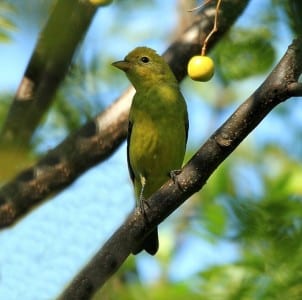
There are those who wouldn’t believe this was a male Scarlet Tanager! In fall, while the Summer Tanager males stay red, these tanagers say, “Frankly, scarlet, I don’t give a dang.” And theyturn green. When they return in April there is no telling what the males will look like, with all kinds of bizarre mixes of green and red. By May, most males are scarlet with their telltale black wings.
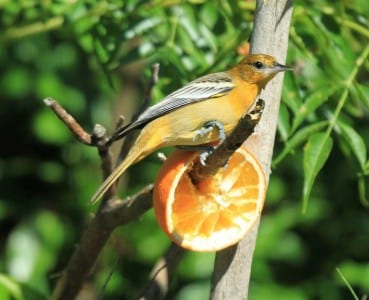
The family of orioles represents both beauty as well as some tough identifications. Just as red is a tanager color and blue is a bunting color, orange is the hue we think of when pondering orioles. The long, sharp bill is handy for the nectivorous life and social gatherings are often found around oranges and other fruit. A word of caution about Baltimore and Bullock’s Orioles: These two species, which were recently considered one species, can be extremely hard to separate in certain plumages. My suggestion would be a recent field guide and hard study. Female Orchard and Hooded Orioles are also very challenging, so beware!
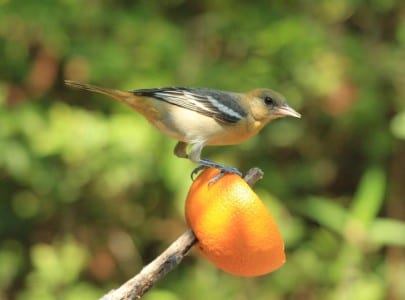
Some first-year Baltimore Orioles are very drab, resembling female Bullock’s (of all ages) in a strong way. For years, this bird was called female Bullock’s by many, and the fact the two were considered one species (Northern Oriole) for many years didn’t help. Curiously, the female Bullock’s has a brighter orange head, as well as a flat, grayer back. There’s nothing that under-educates people like erroneous books. 😉 Male Baltimore Orioles in their first year actually resemble adult females (except for the head) and won’t gain the brilliant colors of the adult male until early spring. Remember that immature birds gain their adult size within six weeks so their youth is no impediment to their migration (at least not physically). The mental process of learning the route and various “tricks of the trade” is probably a different story (leaving many first year birds dead along the way). Cecilia, do you agree?
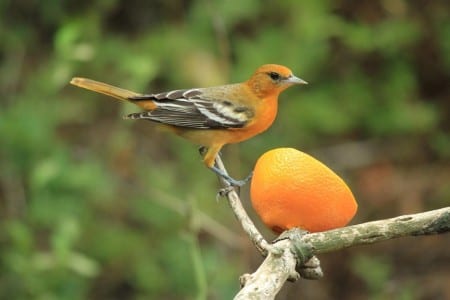
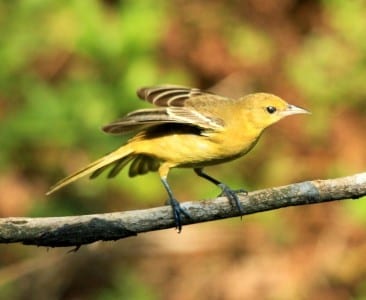
This female Orchard Oriole is getting pretty late, on September 24. This species is rarely seen in October, not unlike Eastern Kingbirds. Circum-Gulf migrants are early movers, since part of the reason they go “around” the Gulf is that there are not normally north winds (to help them across the Gulf) in August and September. Therefore, most circum-Gulf migrants migrate in August and September and most trans-Gulf species cross in October (when there are more cold fronts with north winds). Nature makes sense, doesn’t it? 😉 Speaking of challenges, the bewildering transient thrushes can be murder to the beginner birder. Our most common species in the fall migration is the above species, the Swainson’s Thrush, as most of its kin migrate well east of our location in Texas. Indeed, the big numbers and diversity of thrushes are in Florida in fall and Texas in spring, as many birds migrate in somewhat of a loop.
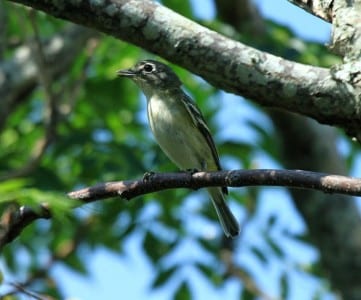
As our breeding and passage vireos leave the Continent for the Tropics, the Blue-headed Vireo drops down from the North for a balmy winter in the Deep South. A grayish bird with bold white eye-rings, these hide in southern forests and scold anything and everything that happens by. You can see how their color matches deciduous forests, absent of leaves and the bright colors of spring and summer.
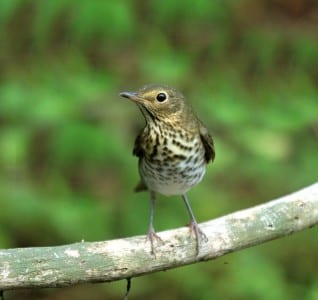
The Swainson’s is easily identified by the buffy eye-ring, and truthfully, we get few other migrant thrushes until the wintering Hermit Thrushes arrive. They lack the eye-ring and are easily identified by their reddish tail. Gray-cheeked and Wood Thrushes are scarce in Texas’s fall migration, due to the birds’ eastern flight.
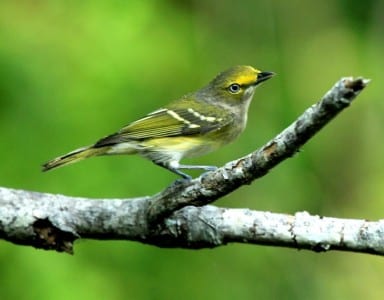
Vireos are often called warblers by beginners but note the cylindrical bill with a hook on the tip (for pulling out caterpillars). Our two most abundant species are the White-eyed (above) and the ubiquitous Red-eyed. On their breeding grounds, most vireos are hard to see, disappearing in canopies like leaf ghosts. In the migration they are much more conspicuous with less foliage and smaller trees.

As our breeding and passage vireos leave the Continent for the Tropics, the Blue-headed Vireo drops down from the North for a balmy winter in the Deep South. A grayish bird with bold white eye-rings, these hide in southern forests and scold anything and everything that happens by. You can see how their color matches deciduous forests, absent of leaves and the bright colors of spring and summer.
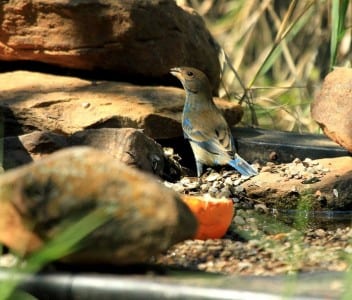
Seed-eating birds are later migrants than insectivorous species, as seeds need to fall for the granivores. We get large numbers of Indigo Buntings within ten days of October 1 but most are plain brown. Some of the males have portions of blue, especially on the wings and tail. This picture shows you patches of blue on those two sites, as well as the legs, neck and head. Curiously, other buntings like the Painted, maintain their bright colors the entire year.
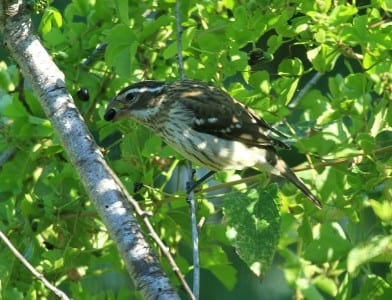
Grosbeaks are much larger than buntings and love fruit! This is a female Rose-breasted Grosbeak, looking more like a huge sparrow than a finch. This species passes through the Gulf coast in large numbers in early October, then returning mostly in April. Curiously, this species is extremely tame while the Blue Grosbeak of open fields is wary as all get-out. Isn’t it curious how some birds are wary and others are tame?
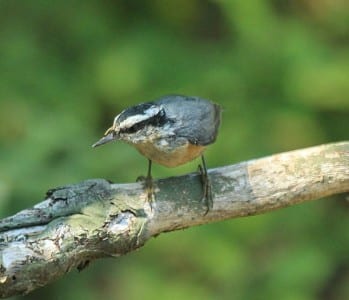
Nut Hatches are mostly non-migratory denizens of pine forests throughout most of the US but the Red-breasted does migrate south in the winter. Occasionally they overshoot their southern target and wind up on barrier islands such as Galveston. Amazingly, Liz and I had three (!) over the last ten days, with only one the past 17 years. This is probably because they do not live north of here in the Great Plains, but further west, where the recent cold fronts emanated. How cool is that?
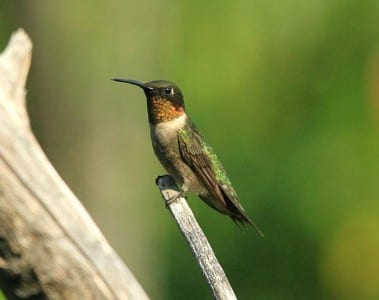
While not songbirds, hummingbirds seem a part of the mix somehow. The dominant species all over our Country’s East is the Ruby-throated, with other species hardly more than accidentals. It is a curious ecological fact that here in Galveston, we have 98% of the same species as 1000 miles east of here, but are considerably different from 200 miles west of our location. Their hummer is the Black-chinned. This depicts the difference between the Eastern Deciduous Forest and the Great Plains.
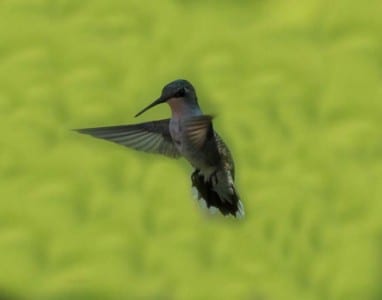
Female hummers lack the colorful gorget you saw on the ruby-throat’s picture and some are quite difficult to tell from other species (such as Black-chinned females). Few birds can hover like hummingbirds and I find it one of the great miracles of Life on Earth that they fly in spring back across the Gulf of Mexico to our shores. In fall, most seem to go around the Gulf as circum-Gulf migrants.

 Posted in
Posted in 























